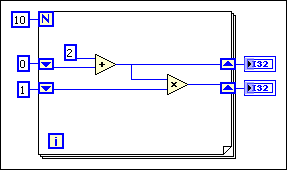How To Add Shift Register In Labview
Shift Registers: Passing Values betwixt Loop Iterations
LabVIEW 2018 Help
Edition Date: March 2018
Office Number: 371361R-01
View Product Info
DOWNLOAD (Windows Only)
Utilise shift registers when you want to laissez passer values from previous iterations through a loop to the side by side iteration. A shift register appears every bit a pair of terminals, shown every bit follows, directly opposite each other on the vertical sides of the loop edge.

The terminal on the correct side of the loop contains an upward arrow and stores data on the completion of an iteration. LabVIEW transfers the data stored in the right concluding of the shift register to the left terminal. The loop and so uses the data from the left concluding as the initial values for the next iteration. This process continues until all iterations of the loop execute. After the loop executes, the concluding on the correct side of the loop returns the final value stored in the shift register.
A shift register transfers any data type and automatically changes to the data type of the outset object wired to the shift register. The information y'all wire to the terminals of each shift register must be the same type. When an error cluster is wired to a shift annals on a parallel For Loop, the shift register converts to an error register.
Yous can add more than one shift register to a loop. If you take multiple operations that use previous iteration values within a loop, use multiple shift registers to store the data values from those different processes in the structure, as shown in the following cake diagram.

In the previous cake diagram, the upper right shift register last transfers 2, the sum of 0 and 2 in the starting time iteration, to the upper left terminal as the initial value for the second iteration of the addition operation. The lower right last transfers two, the product of ane and 2 in the get-go iteration, to the lower left terminal as the initial value for the 2nd iteration of the multiplication operation.
The second iteration adds ii and 2 and transfers the issue, 4, to the upper left concluding for the third iteration. The 2nd iteration likewise multiplies 2 and 4 and transfers the effect, eight, to the lower left terminal for the third iteration.
After ten iterations, the upper correct terminal transfers the final outcome of the addition operation to the upper indicator and the lower correct final transfers the final outcome of the multiplication operation to the lower indicator.
 Information Communication Methods Home
Information Communication Methods Home
WAS THIS Article HELPFUL?
How To Add Shift Register In Labview,
Source: https://zone.ni.com/reference/en-XX/help/371361R-01/lvconcepts/shift_registers_concepts/
Posted by: hallconsicur1998.blogspot.com


0 Response to "How To Add Shift Register In Labview"
Post a Comment